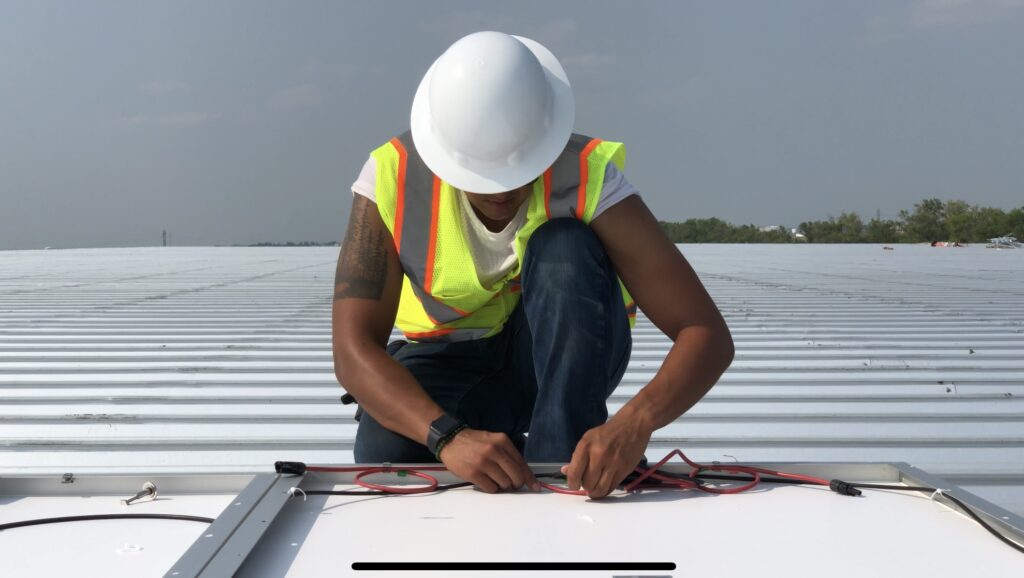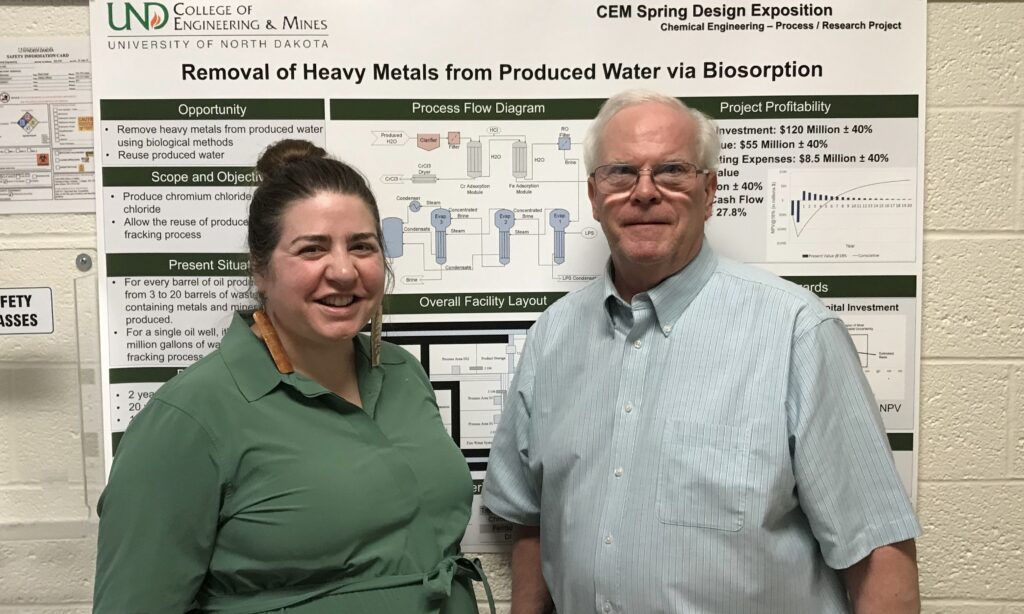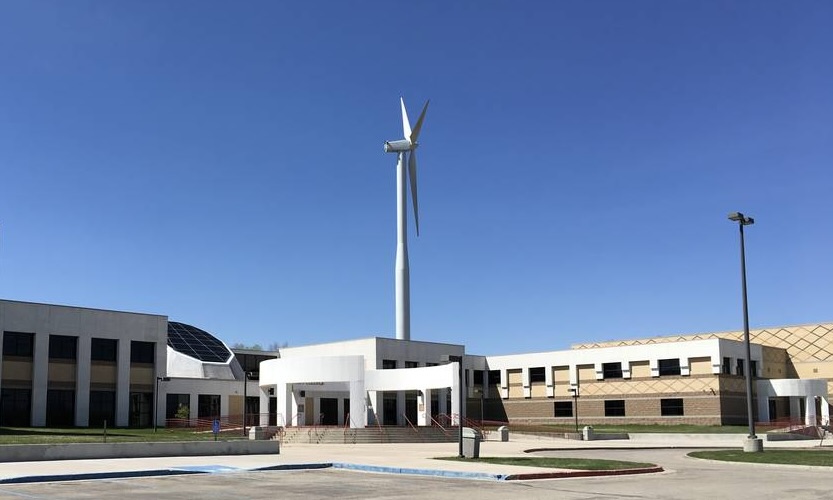Federal grants to reservations and tribal colleges are accelerating the development of “microgrids”— small-scale electrical systems that provide reliable energy to regions poorly served by utilities.
By Melanie Lenart

For too long, many homes on tribal nations have lacked basic services, including electricity. Often, the sprawling landscapes and rural location of Indigenous populations made it prohibitively expensive to get citizens wired into the electrical grid.
But times are changing. Technological advances in renewable energy, along with a series of federal grants, are promoting the concept of microgrids in Indian Country. Recent grants totaling $65 million upped the previous decade’s federal funding averaging about $10 million a year.
And that’s not counting research projects involving renewable energy on tribal nations. One such project involves a $4 million National Science Foundation initiative, funded through the EPSCoR program, supporting collaboration among several research universities and tribal colleges.
Led by the University of North Dakota, the four-year grant pairs researchers in renewable energy with tribal nations and colleges interested in developing more resilient, reliable, and sustainable energy systems for tribal communities. The project also includes training Indigenous students in the engineering skills that can contribute to this goal.
“Within the terms of the regular grid that we have, tribal communities are often at the end of the grid,” said Beth Klemetsrud, a University of North Dakota assistant professor in chemical engineering. “And so when there are disruptions that occur—and lately it’s been due to climate change, which is only going to be exacerbated in the future—these rural, remote tribal communities are often going to be the ones who pay the brunt of it.”
Kansas-based Haskell Indian Nations University, and Turtle Mountain Community College and Nueta Hidatsa Sahnish College, both in North Dakota, are partnering with UND, North Dakota State University and Kansas State University and leading the way on one of the grant goals: to attract more Indigenous students into engineering, including by working on renewable energy projects deemed relevant by the tribal nations involved.
“When it comes to community values, renewable energy is high up there in most tribal communities,” said Klemestrud, a lineal descendent of the Oneida and Brotherton tribes who grew up on the White Earth Nation. “Just growing up in a tribal community, you have great respect and value for Creation, for Mother Earth.”

Microgrids for tribal nations
Klemetsrud and the other three principal investigators who wrote the grant hope their work will help interested parties develop renewable energy “microgrids”—local power supplies that can be tied into the larger grid or operate independently at a smaller scale to serve, homes, campuses and neighborhoods, even villages.
These small-scale systems can actually provide more reliable energy by protecting homes from large-scale disruptions to grids managed by large utilities. In some cases, such as a project for the Hopi villages of Upper and Lower Moenkopi in Arizona, they might be the only grid serving an isolated community. Other systems might supplement the larger grid or ensure continued functioning of crucial services, as with the San Carlos Apache Tribe’s plans to set up a 750-kilowatt solar system to supplement supply for five hospital buildings and 36 homes for health care workers.
“One of the best examples of what happens when grids get too large is what happened in Texas,” she said. “The whole state was shut down because of an ice storm. So how would that have been different if there were more microgrids set up within the giant grid system?”
While Klemetsrud specializes in projects to create fuel to run electrical turbines from plastic and other wastes, others on the team work on solar power, battery storage and the technology of automating systems for energy efficiency.
Co-PI Hongyu Wu, an associate professor at Kansas State University, said microgrids can tie into the larger grid, exchanging power as needed, or operate independently in what he called “island mode.”
“The beauty of the microgrid is that we also have the island mode,” Wu said. “During an emergency situation like tornadoes, or floods, whatever’s happening, when the outside grid is in blackout or something, microgrids can use their own generation, their own energy.”
The microgrid includes the systems used to generate power—such as solar panels, thermal solar for heating, geothermal energy, wind energy, and energy created from waste—as well as the batteries and other materials used to store excess energy generated for later use. Reliable storage is crucial for operating outside of a fossil-fuel-powered grid, as solar panels only generate electricity during the day, and windmills only generate electricity when the wind blows.
The high cost of batteries has been a sticking point for microgrids operating in island mode. Federal incentives, which the research team can help tribal nations identify and seek, are helping to make the costs more manageable, he said, as are ongoing technological advances.
Tribal nations that have been pursuing recent federal incentives for electric vehicles on their nations can find the car batteries can come into play as well. When electric cars are plugged into the grid, their batteries can store energy that can help stabilize fluctuations in the wind or sunshine powering the system.
“Electrical vehicles are going to play a bigger role in the future in terms of providing an energy service,” Wu said. “We call it vehicle-to-grid technology. Most of the time the electric car is connected to the grid and charging so we can use the energy that way.”
Wu has expertise in working with large-scale electrical grids in China, where he received his Ph.D. He shifted his focus to microgrid research while working subsequent positions at the Illinois Institute of Technology and the National Renewable Energy Laboratory. Wu also teaches a Kansas State University course on Wind and Solar Engineering that includes teaching students how to install solar and wind systems.
Although this is his first project working with tribal nations, he is ready to take the approach recommended by Indigenous scholars to see what topics interest community members before posing a specific research question.
“We need to listen, carefully listen, to what the tribes need,” Wu said. “We’re leading the technology (side), but the tribes are leading which direction to go.”
The principal investigators deliberately wrote the proposal to allow for input from the participating tribal nations, Klemetsrud said, adding “I think NSF has listened more to the tribal colleges and community members about how research universities should be working with them, and so I think this was something NSF wanted to hear—like, hey, we don’t have our research questions fully set in stone.”
Identifying tribal needs
This is where the expertise and reputation of another partner, the Tribal Nations Research Group, comes into play. The research group members have already recruited participants from their own nation, the Turtle Mountain Band of Chippewa, as well as the Prairie Band of Potawatomi and the Mandan, Hidatsa and Arikara Nation, and are nearing an agreement with at least one other tribal nation.
Tribal Nations Research Group President Anita Frederick said her team will be surveying members of participating tribal nations about their preferences for energy generation along with other socioeconomic data—including how much they would be willing to pay for electricity.
“We could talk Indigenous energy sovereignty, all we want, but if people aren’t willing to pay for that, then it’s not any good,” she said.
Frederick said she worked for 18 years at Turtle Mountain Community College, including in roles as dean of students and director of institutional research, before launching the research organization about 10 years ago. All members of the staff and the board of directors hail from the Turtle Mountain Band of Chippewa Nation. But the success of the research group’s model, with no oversight from either the tribal nation or the tribal college, has given the group credibility in their nation and encouragement to expand their approach to other tribal nations.
“We’re trusted by our community because they know we’ll give them the real picture and the data is going to be unbiased,” Frederick said.
The group also helps with Internal Review Board materials for research projects, and will be involved in sharing the findings with participating communities and tribal nations.
The researchers also envision sharing some of their results by developing online tools that could help other tribal nations consider how a microgrid might operate on their lands.
“We’re going to provide a very easy-to-use interface so users can just input some numbers and then just get results,” Wu said. “The tribe microgrid tool will be the first of its kind, to the best of my knowledge.”
Both written and interview survey information and other data collected by the research group and the University of North Dakota will inform the research plans, such as where the tribal nation would like to have microgrids, if any, and what types of power generation they favor.
“We have to propose the research we’re going to do and it has to fall in our level of expertise,” Klemetrud said. “But my hope is if they really want to look at advancements in wind energy or geothermal energy that we would be able to connect them with work that’s being done in other institutions and try to help develop that.”
The team is still developing a data management plan, but in general plans call for aggregating any data for sharing beyond those doing the collecting so that they cannot easily be traced back to specific individuals.
Information related to the study of energy system options and sustainable energy solutions may be widely shared among team members, as will data relating to implementing programs that could help recruit, retain and support Indigenous students in engineering at the tribal colleges and research universities.
Engaging students
The research universities will be counting on the participating tribal colleges and universities to lead the way on efforts to recruit students to study engineering in college, Klemetsrud said, and also on how to support students at both tribal colleges and participating research universities.
“The tribal colleges are doing a fantastic job of supporting Native students,” she said. “So, recognizing the tribal college successes and recognizing the fact that they’re the experts in educating Native students, our tribal college partners are really going to help lead the best practices for the engineering program.”
Topics under consideration include identifying resources needed, best practices for checking in with students and setting up study sessions, and the potential need for wrap-around services, such as daycare.
“The goal would be a smoother transfer pathway, there would be better retention of Native transfer students at research universities, and better support for them while they’re here,” Klemetsrud said. “And hopefully providing research opportunities that are within their home tribal communities or other tribal communities.”
In fact, some of the involved tribal colleges already have expertise in setting up and maintaining renewable energy, including the automation that keeps different systems interacting efficiently in a microgrid. Turtle Mountain Community College in Belcourt was generating about 80 percent of its electricity in 2021 from renewable sources, including geothermal and the wind-power generator based on a tribal college campus. And that was before it began to add solar power to the mix.

Nueta Hidatsa Sahnish College on the Fort Berthold Reservation now has an associate of science degree in Sustainable Energy that provides students with “the education needed to become solar installers, technicians and operators of both solar and wind technologies.”
“Native Americans and Indigenous peoples are leading the way for fighting climate change and reducing global warming impacts,” Klemetsrud said. “Can we develop the different technologies that we need to help make it a little bit more bearable or adapt more as the climate changes? Which is why I think microgrids are sort of the future of what our electricity situation looks like.”
Melanie Lenart is a contributing editor to Native Science Report.
Story published September 18, 2023
• • •
Enjoyed this story? Enter your email to receive notifications.
